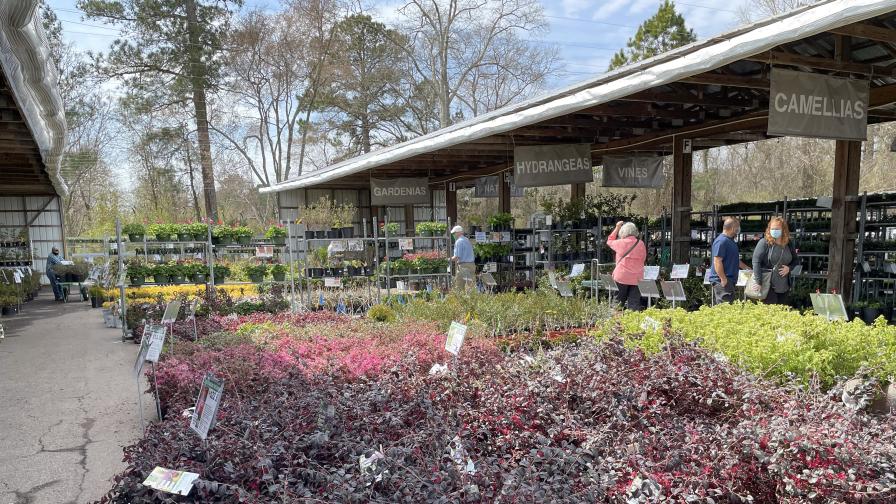4 Garden Trends as Seen Through a Plantsman’s Eyes

Growers Outlet in Loganville, GA, has had a very busy spring this year, with shoppers flocking to its outdoor displays to seek out a wide range of shrubs and perennials. Can you spot the Passionates?
Photo by Allan Armitage
I have talked and visited with many plant people this spring. I often marvel at what I hear, not from California trials and Cultivate attendees or from other renowned experts, but rather from people who just make our industry better.
I am not sure if what I hear about can be called trends, but they show how diverse our industry is and how impossible it is to define this thing we call horticulture.
Too Few or Too Many Plants?
One of our bright stars of horticulture, Marianne Willburn from Lovettsville, VA, (Marianne is a garden writer who runs the website SmallTownGardener.com) suggested that whether she’s in Virginia, Ohio, Georgia, or California, most of the plants she sees offered to consumers are exactly the same. Regardless of location, she sees the same petunias, the same hydrangeas, and the same coneflowers at box stores and even at independent garden centers. She asked me why lesser-known plants are harder to find. In essence, we debated whether there were not enough or too many choices at retail.
We concluded that it depends on the audience. For crazy garden people like Marianne and myself, we can never find our beloved Browallia or our grandmother’s Abutilon. Heck, it is hard enough to find a petunia labeled with the cultivar name. People like us often find ourselves on some obscure and expensive Internet site ordering plants we need to have, but ones that no one other than passionate gardeners have even heard of.
However, for our daughters and our neighbors, who exponentially outnumber the Passionates, there is lots of choice, and in fact, the choice is not only wholly sufficient but better than ever. You and I may have too many hydrangeas or heucheras, and I suppose choosing one may be confusing for our neighbors, but in general, they are better suited to today’s gardener than ever. Similarly, with almost every category, there is more than enough choice for everyday gardeners, and they are more successful as a result. That is the bottom line, and for that I am pleased.
Where Is the Garden Furniture?
I have often said that there are not enough of the above-mentioned Passionates to sustain retail garden centers. Thus, the evolution of garden center plant stores to lifestyle centers. Barbeques, upscale garden furniture, brand-name containers, bird houses, and garden art now take up significant space, often making the plants secondary. I understand this, and more success to them.
Yet, there I was doing a walkabout in March from one of the most wonderful garden centers I know, Growers Outlet in Loganville, GA, run by Marijke Tromp. I was stopping, admiring, and roaming through row after row, shelf after shelf of nothing but plants. Everything was outside under a shed roof, which is why Growers Outlet would never be known as one of the best-looking garden centers. However, shrubs, perennials, vegetables, and even containers of bulbs were well labeled, well priced, and well bought.
Only a few hundred or so people were bundled up when I was there that day, but they were buying. In April and May, there are so many Passionates that Marijke hired police to direct traffic and purchased significant acreage for additional parking. When I asked the group with me that day if they missed the lack of garden furniture and accessories, not one person said yes. They are part of a lesser-known group of Passionates, and not only do they still exist, they are growing.
Who Is Taking Care of The Children?
Joan Stevens teaches young and not-so-young students at community colleges in Pasadena, CA. She is part of the unsung group of heroes who teach at community colleges, without whom the future of this industry would be very much in doubt. They don’t get as much press as those who do research and teach at well-known four-year institutions, and their student make-up often consists of those already in the work force looking for change. Often, the students are older and, in general, they lean heavily on the Joan Stevens of the industry for guidance.
We chatted about many things that her students might be interested in, from plant breeding to retail. But what she really wanted to share with them were the opportunities in horticulture. I was pleased to share my experiences with her and her students, but what impresses me most about Joan and so many others like her is her perseverance and her belief that this industry is one well worth getting people excited about.
The Minis
Joan mentioned something else as we were about to sign off. She is also a cut flower grower and couldn’t help but comment on the amazing growth of the mini-cut flower growers. These are people growing cut flowers on very small acreages, often in their back yards, and marketing themselves through farmers’ markets, events, and celebrations. They have accepted, and in many cases, embraced the fact that they will never be rich or social media mavens. They may be small, but many are smart enough to join the Association of Specialty Cut Flower Growers, one of the most member-effective organizations I know.
The mini-cut people have always been around, but they were often dabblers. We used to give them a year at best before they disappeared. Today’s mini-grower is a quite different kind of animal, content with the lifestyle and happy to make a difference. Rather than disappearing, their numbers have swollen. They are an important part of the American cut-flower industry, one more aspect of our diversity that makes me proud.









